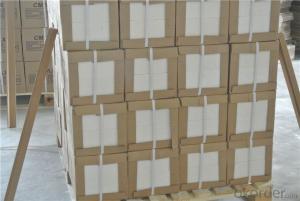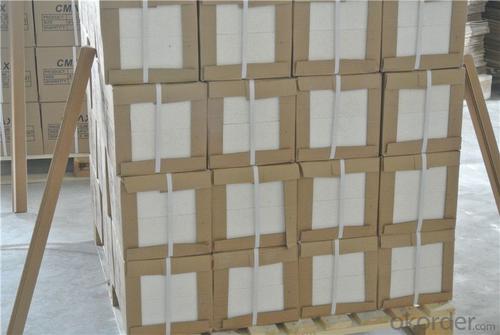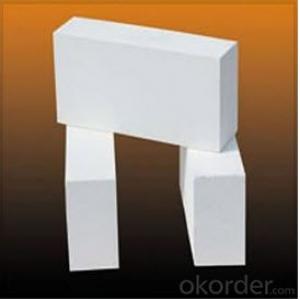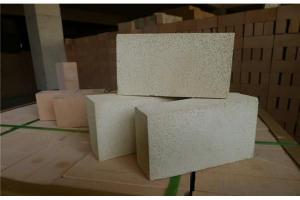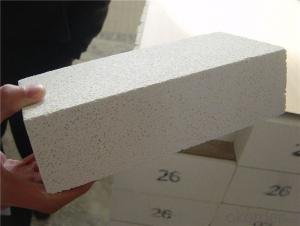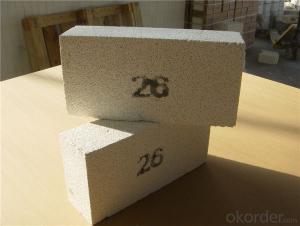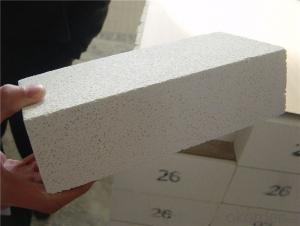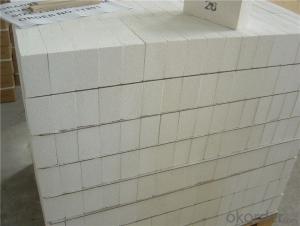GJM 23 Light Dense Mullite Insulating Fire Brick
- Loading Port:
- Shanghai
- Payment Terms:
- TT OR LC
- Min Order Qty:
- 1 m.t.
- Supply Capability:
- 10000 m.t./month
OKorder Service Pledge
OKorder Financial Service
You Might Also Like
Thermal Insulation Fire Clay Brick
Refractory brick is a refractory material used in lining furnaces, kilns, fireboxes, and fireplaces.
We provide high quality Refractory Fire Bricks that are used on wide range in the various industries like Cement, Glass and Steel. Refractory Fire Bricks are provided as per the quantity and specifications required by the customers. We provide an extensive range of Refractory Fire Bricks at reasonable prices that depend upon the quantity ordered.
Application
Insulating Fire Brick are used for the lining of converter, alternating current arc furnace, direct Current arc furnace and the ladle slag line, etc.
Company Advantage
(1)Long Insulating Fire Brick manufacture history: 25 years manufacturer
(2)Advanced equipment and good service
(3)Diversification of production standards: ISO ANSI FEPA JIS ASTM
(4)Flexible payment: T/T L/C D/P D/A
(5)Professional marketing team and after-sale service
Insulating Fire Brick main feature:
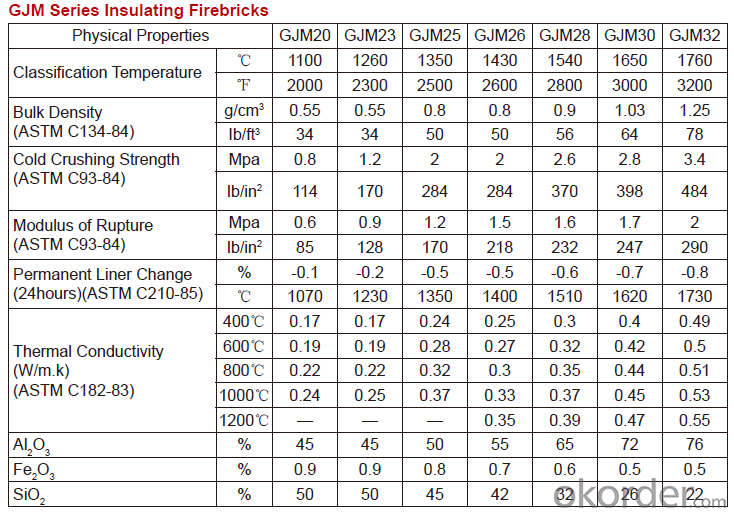
Equipment
1 unit of Ceramic Abrasive (SG Abrasive) pilot production line
2 units of Compact grain Abrasive pilot production lines
1 unit of high-end coated abrasives (abrasive cloth) production line
3 large flexible crushing and sieving lines for grit production lines
6 units of 5000KVA-10000KVA dumping type electric arc furnaces for Brown Fused Alumina fusion
FAQs
Q1 What’s the transport method?
A1 FCL delivery goods with wooden pallet or wooden case by sea; If LCL delivery, must with wooden case; Sometimes need open top, flat rack or bulk cargo.
Q2 What’s the required payment term?
A2 Generally 30% TT as the prepayment, 70% TT before delivery. If need, 100% Irrevocable Letter of Credit or negotiation.
Q3 Which country are our products exported to?
A3 Apart from entire Chinese market, the US, Russia, Japan, Korea, Australia and some Southeast Asian Nations.
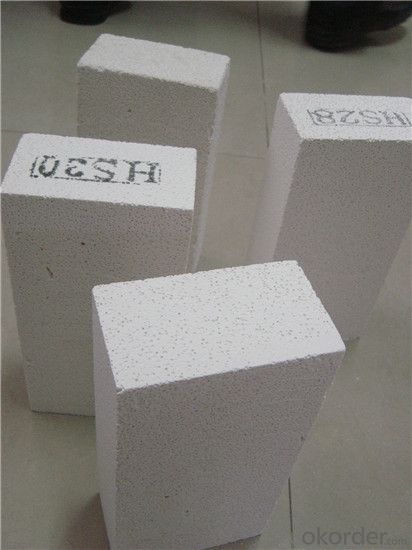

- Q: Are insulating fire bricks resistant to acid attack?
- Insulating fire bricks are known for their resistance to acid attack. They are manufactured using durable materials that can withstand high temperatures and offer excellent insulation properties. These bricks are typically composed of lightweight refractory materials like alumina, silica, and other refractory oxides, which are renowned for their ability to resist chemical corrosion, including acids. Nevertheless, it is crucial to acknowledge that the acid resistance of insulating fire bricks can vary depending on their specific composition and manufacturing process. Some bricks may exhibit higher resistance to acids than others. Therefore, it is advisable to consult the manufacturer or supplier for detailed information regarding the acid resistance of their insulating fire bricks. Generally, insulating fire bricks are widely used in various applications where they may encounter acids, such as industrial furnaces, kilns, and high-temperature environments. They are valued for their durability and capacity to withstand harsh chemical surroundings, including acid exposure. However, it is always essential to consider the precise chemical composition and concentration of the acids involved, as well as the temperature conditions, to determine the suitability of insulating fire bricks for a particular application.
- Q: Can insulating fire bricks be used in the construction of pizza ovens?
- Indeed, it is possible to utilize insulating fire bricks during the construction of pizza ovens. With their ability to endure extreme temperatures and offer exceptional insulation, these bricks become an excellent choice for pizza ovens. They aid in the efficient preservation of heat, thus leading to a more uniform and steady cooking temperature. Additionally, due to their low thermal conductivity, insulating fire bricks effectively prevent heat dissipation, ensuring that the pizza oven remains hot for extended durations, thereby enhancing energy efficiency. All in all, incorporating insulating fire bricks into the pizza oven construction process can result in enhanced heat retention, improved cooking performance, and a more energy-efficient operation.
- Q: Can insulating fire bricks be used in the construction of hearths?
- Indeed, hearths can be constructed using insulating fire bricks. These bricks are specifically engineered to endure extreme temperatures, rendering them a superb selection for hearth construction. With their low thermal conductivity, they effectively retain heat and hinder the transmission of heat to nearby surroundings. Consequently, they are perfect for establishing a well-insulated and efficient hearth. Furthermore, their lightweight and manageable nature make them highly convenient for construction tasks. All in all, insulating fire bricks prove to be a dependable and pragmatic choice for the development of hearths.
- Q: What is the cost of insulating fire bricks?
- The cost of insulating fire bricks can vary depending on various factors such as the quantity needed, the quality of the bricks, and the supplier. On average, insulating fire bricks can range from $2 to $5 per brick. However, the price can go higher for specialty bricks or those with specific features such as higher insulation ratings or increased durability. It is always recommended to obtain quotes from multiple suppliers to compare prices and ensure the best value for money.
- Q: Can insulating fire bricks be used for insulation in chemical plants?
- Yes, insulating fire bricks can be used for insulation in chemical plants. These bricks are designed to withstand high temperatures and provide excellent thermal insulation, making them suitable for insulating equipment, furnaces, and other structures in chemical plants where heat management is crucial.
- Q: Can insulating fire bricks be used in the construction of flue liners?
- Yes, insulating fire bricks can be used in the construction of flue liners. Insulating fire bricks are designed to withstand high temperatures and provide excellent insulation properties. These bricks are made from lightweight materials such as vermiculite or perlite, which have low thermal conductivity. This makes them ideal for lining flues, as they can help to retain heat and improve the efficiency of the flue system. Additionally, insulating fire bricks are resistant to thermal shock and can withstand rapid temperature changes, which is important in flue applications where the temperatures can fluctuate significantly. Overall, using insulating fire bricks in the construction of flue liners can help to enhance the performance and safety of the flue system.
- Q: How do insulating fire bricks help improve the efficiency of heat recovery systems?
- Insulating fire bricks are essential for improving the efficiency of heat recovery systems in multiple ways. To begin with, these bricks are crafted from top-notch insulating materials like ceramic fiber, which possess exceptional thermal properties. This implies that they exhibit a low thermal conductivity, thus preventing the escape or wastage of heat. By incorporating insulating fire bricks as lining materials in heat recovery systems, the heat exchange process becomes more efficient as less heat is lost to the surroundings. Furthermore, insulating fire bricks aid in reducing heat transfer through conduction. They serve as a barrier between the hot and cold sides of the system, thereby minimizing heat loss through direct contact. This insulation effect enables the heat recovery system to maintain a higher temperature on the hot side, maximizing the temperature difference and ultimately enhancing the rate of heat transfer. In addition, these fire bricks are lightweight and possess low heat storage capabilities. Consequently, they require less energy for heating and cooling, resulting in faster response times for the heat recovery system. This quick response enables the system to adapt swiftly to changes in heat generation or demand, thereby improving its overall efficiency. Moreover, the utilization of insulating fire bricks as refractory materials in heat recovery systems aids in reducing energy consumption. Since these bricks can withstand high temperatures without cracking or deforming, they contribute to the system's longevity, reducing the need for frequent repairs or replacements. This leads to lower maintenance costs and less downtime, ultimately enhancing the overall energy efficiency of the heat recovery system. To summarize, insulating fire bricks bolster the efficiency of heat recovery systems by providing superb thermal insulation, minimizing heat loss through conduction, enabling rapid response times, and reducing energy consumption. Their incorporation as lining materials significantly enhances the heat transfer process, resulting in more effective heat recovery and utilization.
- Q: Are insulating fire bricks resistant to thermal radiation?
- Yes, insulating fire bricks are designed to be resistant to thermal radiation. These bricks are made from materials that have low thermal conductivity and high thermal resistance, allowing them to effectively insulate against heat transfer through radiation.
- Q: Can insulating fire bricks be used as a thermal barrier?
- Yes, insulating fire bricks can be used as a thermal barrier. Insulating fire bricks are specifically designed to have low thermal conductivity, meaning they are able to effectively reduce heat transfer. This makes them an excellent choice for thermal insulation applications. They are commonly used in industries where high temperatures are involved, such as in furnaces, kilns, and other heat-intensive processes. Insulating fire bricks can help to minimize heat loss, maintain consistent temperatures, and improve energy efficiency. Additionally, their lightweight nature makes them easy to handle and install, further enhancing their suitability as a thermal barrier.
- Q: Are insulating fire bricks suitable for insulation in chemical reactors?
- Yes, insulating fire bricks are suitable for insulation in chemical reactors. These bricks are made of lightweight materials such as clay and have a high insulating property, which helps to minimize heat loss and maintain stable temperatures inside the reactor. Additionally, they are resistant to thermal shock and can withstand high temperatures, making them an ideal choice for insulation in chemical reactors.
Send your message to us
GJM 23 Light Dense Mullite Insulating Fire Brick
- Loading Port:
- Shanghai
- Payment Terms:
- TT OR LC
- Min Order Qty:
- 1 m.t.
- Supply Capability:
- 10000 m.t./month
OKorder Service Pledge
OKorder Financial Service
Similar products
Hot products
Hot Searches
Related keywords
